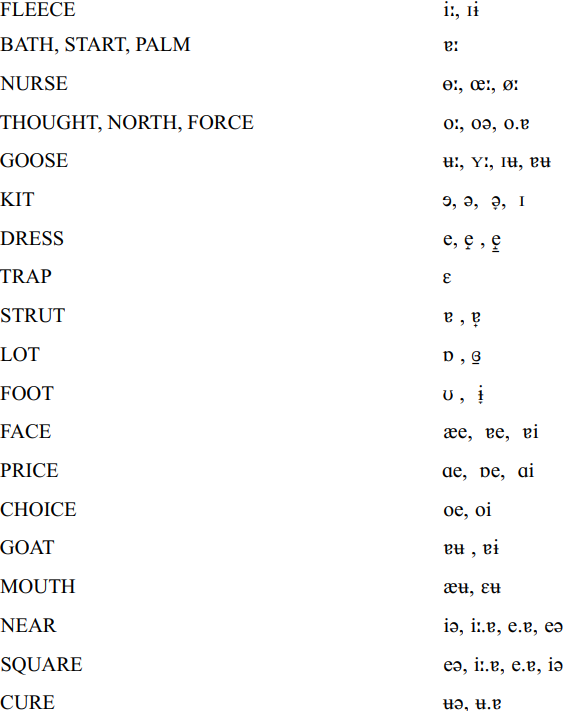


 Grammar
Grammar
 Tenses
Tenses
 Present
Present
 Past
Past
 Future
Future
 Parts Of Speech
Parts Of Speech
 Nouns
Nouns
 Verbs
Verbs
 Adverbs
Adverbs
 Adjectives
Adjectives
 Pronouns
Pronouns
 Pre Position
Pre Position
 Preposition by function
Preposition by function 
 Preposition by construction
Preposition by construction
 Conjunctions
Conjunctions
 Interjections
Interjections
 Grammar Rules
Grammar Rules
 Linguistics
Linguistics
 Semantics
Semantics
 Pragmatics
Pragmatics
 Reading Comprehension
Reading Comprehension|
Read More
Date: 2024-06-22
Date: 2024-12-07
Date: 2024-03-21
|
New Zealand English has, with very minor exceptions, a standard non-rhotic stressed vowel system. The lexical sets are assigned to phonemes as below, with the first symbol in the set of illustrative qualities being the one we select for a phonemic transcription.

Some of these will be discussed in more detail below, in particular the NEAR – SQUARE merger is a process of great interest in the phonology of current New Zealand English.
Lip-rounding and spreading is never strong in New Zealand English. There is some as-yet unexplained articulatory compensation for lip-rounding which can give the auditory impression of lip-rounding without any difference in the actual lip-position. Talk of lip-rounding in the descriptions below must be understood in terms of this mechanism rather than in terms of the expected pouting gesture. A video of one female speaker pronouncing a number of New Zealand English vowels is provided on the accompanying CD-ROM and in the online version. Her lip movement seems to us to be greater than is found with many speakers – perhaps because of the formal environment of the recording and the fact that she was reading isolated words. An interesting comparison can be made to illustrate this, using the recordings for herd and word. The former is taken from the word-list and the latter from an impromptu remark by the speaker, albeit produced with accompanying laughter, which contributed to the different lip shape. The comparison is interesting not just as an illustration of the different lip shape in formal and informal contexts, but also because auditory and acoustic comparison of the two // vowels shows that they are remarkably similar, despite the different lip configuration. As observed above, there would appear to be some other compensatory articulatory configuration that results in the rounded quality in the absence of rounded lip shape.
The fundamental system given above is subject to considerable neutralization before /r/ and /l/. Much of the neutralization is variable, particularly that before /l/, so that no simple statement of the system in neutralized positions can be given. Furthermore, the context of neutralization does not seem to be consistent for all vowels. In some cases there is neutralization before any /l/, in others the position of neutralization appears to be restricted to where /l/ is in a syllable coda (i.e. after the vowel but in the same syllable), in others to environments where the /l/ is not only in a coda but followed by an obstruent (perhaps particularly voiceless obstruents).
The phonemes instantiated in the following lexical sets are generally neutralized before /r/:

Note that this pattern is complicated by the NEAR-SQUARE merger where that occurs.
The phonemes instantiated in the following lexical sets are frequently neutralized before /l/
|
|
|
|
دخلت غرفة فنسيت ماذا تريد من داخلها.. خبير يفسر الحالة
|
|
|
|
|
|
|
ثورة طبية.. ابتكار أصغر جهاز لتنظيم ضربات القلب في العالم
|
|
|
|
|
|
|
العتبة العباسية المقدسة تقدم دعوة إلى كلية مزايا الجامعة للمشاركة في حفل التخرج المركزي الخامس
|
|
|